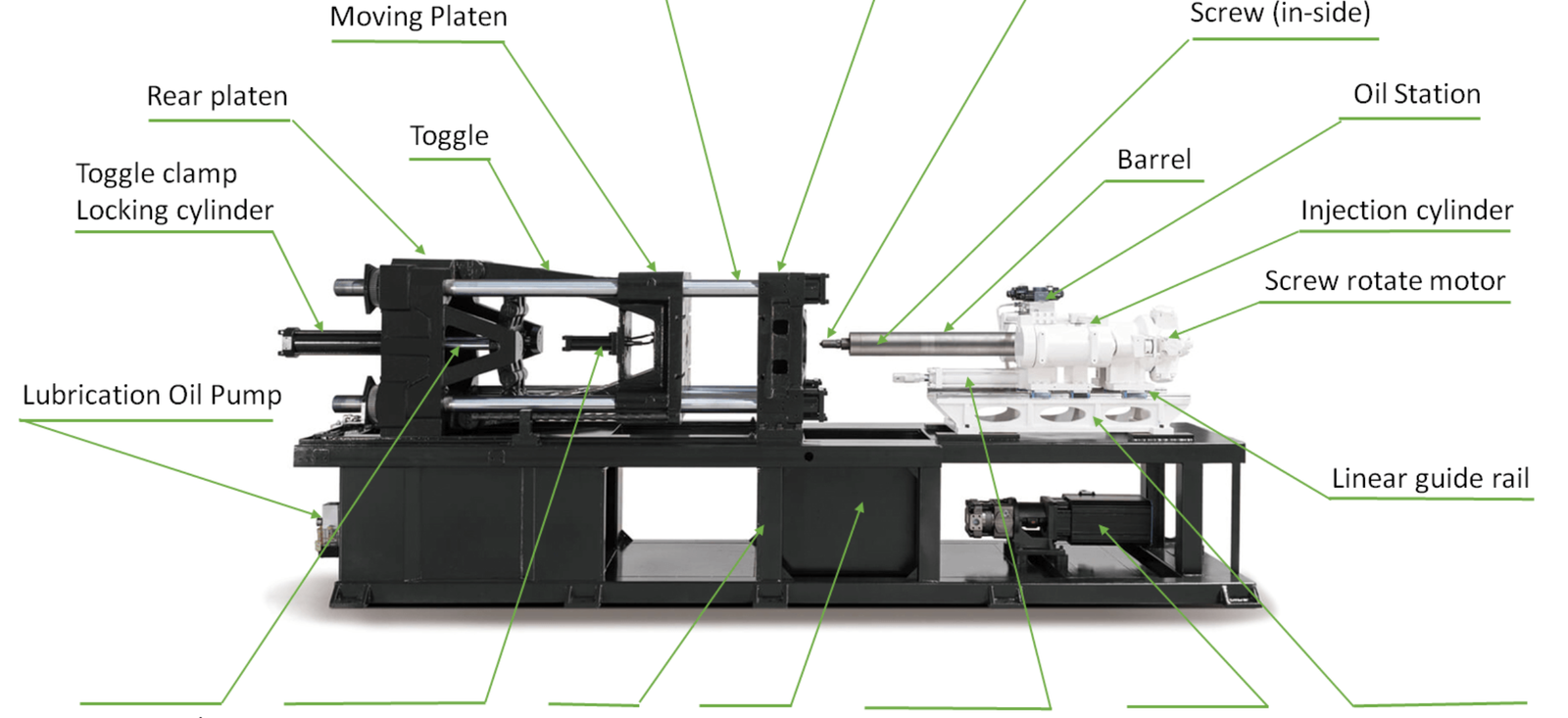Introduction
Injection molding machines play a crucial role in the plastic processing industry. These machines use heat and pressure to turn raw plastic materials into a wide variety of products by injecting melted plastic into molds. They are used in many industries such as automotive, consumer goods, medical devices, and packaging.
It is important to have a good understanding of how to use and maintain these machines properly. This knowledge is key to achieving optimal performance and ensuring the longevity of the equipment. When an injection molding machine is well-maintained, it can:
- Ensure consistent production quality
- Minimize downtime
- Extend the lifespan of the equipment
In this guide, we will share with you 10 essential tips for using and maintaining your injection molding machine correctly. By following these tips, you will be able to maximize the lifespan and performance of your machine, leading to greater efficiency and profitability in your operations.
1. Understanding Injection Molding Machines
Injection molding machines are crucial in the plastic processing industry. They allow for the efficient and precise mass production of complex plastic parts. These machines consist of three main systems:
- Hydraulic System: Powers the movement of various machine components.
- Electrical System: Controls the machine’s operations and ensures accurate performance.
- Mechanical System: Comprises various mechanical parts that require regular lubrication and inspection.
Each system plays a crucial role in the overall functionality of the injection molding machine. It is important to have a proper understanding of these systems for effective maintenance and optimal performance.
2. Importance of Preventive Maintenance
Preventive maintenance involves regular inspections, cleanings, and repairs to prevent unexpected breakdowns and extend the machine’s lifespan. Here’s why it is essential for injection molding machines:
- Reduces Downtime: Regular maintenance helps identify potential issues before they become significant problems, minimizing production interruptions.
- Improves Efficiency: Well-maintained machines operate more efficiently, leading to higher output and better product quality.
- Cost Savings: Preventive maintenance can save money by reducing the need for costly emergency repairs and extending the life of expensive components.
Implementing these preventive maintenance practices ensures your injection molding machine operates smoothly, reduces downtime, improves efficiency, and ultimately extends its lifespan.
3. Hydraulic System Maintenance
Injection molding machines rely heavily on their hydraulic systems to function efficiently. Proper maintenance of the hydraulic system is essential to ensure the longevity and performance of the machine.
Why Regular Maintenance is Important for the Hydraulic System
The hydraulic system in an injection molding machine powers various components, such as the clamping unit and injection unit. Any issue within this system can lead to production downtime, decreased efficiency, and increased operational costs. Regular maintenance helps prevent unexpected failures, ensures smooth operation, and extends the machine’s lifespan.
Specific Steps to Maintain the Hydraulic System
1. Monitoring Oil Viscosity and Temperature
- Oil Viscosity: Regularly check the viscosity of the hydraulic oil. Using oil with incorrect viscosity can lead to inefficient power transmission and potential damage to hydraulic components.
- Temperature Control: Maintain optimal oil temperature. Excessive heat can degrade oil quality, reducing its lubricating properties and leading to increased wear on hydraulic parts.
2. Performing Timely Repairs
- Leakages: Inspect for any oil leakages in hoses, seals, and connections. Addressing leaks promptly prevents contamination and ensures consistent fluid pressure.
- Component Wear: Check for signs of wear in pumps, valves, and cylinders. Replace worn-out parts to maintain system integrity and performance.
3. Regular Oil Testing
- Conduct periodic tests to evaluate oil condition. This includes checking for contamination levels, moisture content, and overall quality. Clean or replace oil filters as needed to keep contaminants at bay.
4. Proper Oil Filling Procedures
- When adding or replacing hydraulic oil, follow manufacturer guidelines meticulously. Use only recommended oil types to ensure compatibility with your machine’s components.
5. Routine Cleaning
- Keep the hydraulic system clean by regularly flushing it and removing any debris or sludge build-up in reservoirs and lines.
Regular attention to these aspects ensures that your injection molding machine’s hydraulic system remains efficient and reliable throughout its operational life.
Maintaining a well-functioning hydraulic system not only boosts your machine’s performance but also contributes significantly to overall productivity in your plastic processing operations.
4. Electrical System Maintenance
Ensuring the electrical system of your injection molding machine remains in optimal condition is crucial for maintaining consistent performance and safety. The electrical system powers essential components, including control panels, motors, and sensors, all of which work together to achieve precise molding operations.
Key Aspects of Electrical System Maintenance:
1. Regular Inspections:
- Conduct routine inspections to detect any signs of wear or damage in wiring, connectors, and electrical components.
- Look for loose connections, exposed wires, or signs of corrosion that could lead to short circuits or machine failure.
2. Proper Cleaning Methods:
- Keep electrical cabinets clean and free from dust and debris. Accumulated dust can cause overheating or short circuits.
- Use appropriate cleaning agents and tools designed for electrical components to avoid causing damage during the cleaning process.
3. Monitoring Electrical Parameters:
- Regularly check voltage levels and ensure they are within the manufacturer’s specified range. Fluctuations in voltage can affect the performance and lifespan of electrical components.
- Monitor current draw on motors and other high-power devices to detect potential issues early.
4. Component Testing:
- Perform diagnostic tests on critical components like contactors, relays, and circuit breakers to ensure they function correctly.
- Use specialized equipment such as multimeters and insulation resistance testers to evaluate component health.
5. Preventive Replacement:
- Replace worn-out or aged components before they fail. This proactive approach prevents unexpected downtime and reduces repair costs.
- Maintain a stock of essential spare parts for quick replacements during maintenance routines.
Examples of Best Practices:
- Schedule monthly visual inspections of all electrical panels and connectors.
- Clean the interior of control cabinets at least once every quarter using anti-static brushes and vacuum cleaners designed for electronics.
- Keep detailed logs of voltage readings, current draws, and any anomalies observed during routine checks.
Benefits of Regular Electrical Maintenance:
- Enhances machine reliability by preventing unexpected interruptions due to electrical faults.
- Improves safety by reducing the risk of electrical fires or malfunctions.
- Extends the lifespan of electrical components through consistent upkeep.
By prioritizing these maintenance activities, you ensure your injection molding machine operates smoothly and safely, contributing significantly to its overall longevity and efficiency.
5. Mechanical System Maintenance
For the longevity of your injection molding machine, maintaining the mechanical system is crucial. This system comprises various moving parts that are vital to the machine’s overall functionality. These components include the clamping unit, injection unit, and ejection mechanisms, each playing a significant role in the molding process.
Key Points for Mechanical System Maintenance:
- Lubrication:Regular lubrication of moving parts reduces friction and wear.
- Use the manufacturer-recommended lubricants to ensure compatibility and effectiveness.
- Establish a lubrication schedule based on usage intensity and environmental conditions.
- Inspection Routines:Conduct routine inspections to identify signs of wear or damage early.
- Check for loose bolts, misaligned components, and unusual noises during operation.
- Use specialized tools like dial indicators to measure critical tolerances and alignments.
- Component Integrity:Replace worn or damaged parts promptly to prevent further damage.
- Focus on high-wear components such as bearings, bushings, and seals.
- Keep an inventory of essential spare parts to minimize downtime during repairs.
- Cleaning:Regularly clean mechanical components to prevent contamination build-up.
- Pay attention to critical areas like guide rails, lead screws, and linear bearings.
- Utilize appropriate cleaning agents that do not corrode or degrade component materials.
- Calibration:Ensure that all mechanical elements are precisely calibrated for optimal performance.
- Perform periodic checks on critical dimensions and settings using precision instruments.
- Documentation:Maintain detailed records of all maintenance activities.
- Document inspection results, lubrication schedules, and part replacements.
- Use this data to identify patterns and improve future maintenance practices.
Example Practices:
- Weekly Inspection: Check the condition of guide rails and apply lubricant if necessary.
- Monthly Calibration: Verify alignment settings for clamping units using dial indicators.
- Quarterly Cleaning: Deep-clean injection units to remove any residual plastic material.
Proper mechanical system maintenance not only extends the lifespan of your injection molding machine but also ensures consistent product quality. By adhering to these practices, you can prevent unexpected breakdowns and maintain efficient production operations.
6. Operator Training and Safety Measures
Operator training is crucial for keeping your injection molding machine running smoothly and efficiently. Well-trained operators can:
- Identify problems early on
- Perform minor maintenance tasks
- Reduce downtime
This section will cover the following topics related to operator training:
Machine Operation {#machine-operation}
It’s important for operators to have a thorough understanding of how the specific machine they’re using works. This includes knowing its functions and capabilities.
Routine Maintenance {#routine-maintenance}
Operators should also be educated on basic maintenance tasks that need to be performed regularly, such as:
- Lubrication
- Cleaning
- Basic inspections
By providing comprehensive training on both machine operation and routine maintenance, you can empower your operators to take better care of your injection molding machine.
Safety measures are equally important. By prioritizing safe practices, you can:
- Minimize the risk of accidents
- Avoid costly downtime
- Prevent harm to your employees
Here are some key safety measures that should be implemented:
- Personal protective equipment (PPE): Operators must always wear appropriate PPE such as gloves, safety glasses, and ear protection.
- Emergency procedures: Clear instructions should be provided on what steps to take in case of an emergency or machine malfunction.
- Regular drills: Conducting safety drills helps ensure that all operators are familiar with the necessary protocols during an emergency situation.
Investing in proper operator training and enforcing strict safety measures not only extends the lifespan of your injection molding machine but also creates a safer working environment for your team.
7. Selecting the Right Injection Molding Machine Model
Choosing the right machine model is vital for effectively meeting your production needs. You should carefully consider several factors to ensure that the machine is reliable and easy to maintain.
Key Factors to Consider:
- Clamping Force: The clamping force must be sufficient to keep the mold closed during injection. Machines that are too small can result in defects, while oversized machines waste energy.
- Shot Size: Make sure that the machine’s shot size matches the volume requirements of your product. If there is a mismatch, it can lead to material wastage or incomplete filling.
- Material Compatibility: Different machines are designed for specific types of plastics. It’s important to check if the machine you’re considering is compatible with the materials you plan to use.
- Cycle Time: Evaluate the machine’s ability to complete each cycle within the required time frame without compromising on quality.
- Precision and Tolerance: For parts that require high precision, choose a machine that offers tight control over tolerances and can consistently produce accurate results.
Reliability and Maintainability:
- Brand Reputation: Established brands often offer more reliable machinery and better support after purchase.
- Ease of Maintenance: Machines that are designed with easy access for maintenance can help minimize downtime. Look for features such as modular components and user-friendly interfaces.
- Energy Efficiency: Models that are energy-efficient can help reduce operational costs in the long run. Check if the machine has any energy-saving certifications or features.
Considering these factors will ensure that your injection molding machine not only meets your current production requirements but also has the flexibility to adapt to future needs, maintaining its performance over time.
8. Extending Machine Lifespan through Comprehensive Maintenance Strategies
Implementing regular maintenance is critical for extending the machine lifespan of your injection molding equipment. A holistic approach to maintenance not only ensures longevity but also optimizes operational efficiency.
Benefits of a holistic approach:
- Reduced Downtime: Regular inspections and timely repairs prevent unexpected breakdowns, ensuring continuous production.
- Cost Savings: Proactive maintenance can minimize costly repairs and part replacements by addressing issues before they escalate.
- Enhanced Performance: Consistent upkeep maintains optimal machine performance, leading to better product quality and increased output.
Key strategies for comprehensive maintenance:
1. Use of Checklists:
- Create detailed checklists tailored to your machine’s specific requirements.
- Include daily, weekly, and monthly tasks such as lubrication, cleaning, and component inspections.
- Ensure operators follow these checklists rigorously to maintain consistency.
2. Scheduling Professional Inspections:
- Regularly schedule professional inspections to identify potential issues that might be missed during routine checks.
- Engage certified technicians for thorough evaluations of electrical, hydraulic, and mechanical systems.
- Use inspection reports to guide future maintenance activities and prioritize critical tasks.
3. Documentation and Record-Keeping:
- Maintain comprehensive records of all maintenance activities including dates, performed tasks, and observations.
- Analyze historical data to identify recurring issues and adjust maintenance practices accordingly.
- Use digital tools or software for efficient record-keeping and easy access to information.
By embracing these comprehensive maintenance strategies, you ensure that every aspect of your injection molding machine is well-maintained, ultimately extending its lifespan and maximizing productivity.
9. Optimizing Production Volume with Efficient Machine Utilization
To optimize production volume while maintaining high quality, it’s crucial to implement strategies that reduce defects and enhance output. Here are some key approaches:
Implementing Process Monitoring Systems
- Using real-time monitoring systems helps you keep track of critical parameters such as temperature, pressure, and cycle times. This allows for immediate adjustments to maintain consistency and quality.
Regular Calibration
- Regularly calibrating your injection molding machine ensures that all components operate within specified tolerances. Accurate calibration minimizes variability in the production process, leading to fewer defects.
Utilizing Advanced Software
- Software tools for simulation and analysis can predict potential issues before they occur. Tools like Moldflow or Simcon help in optimizing mold designs and processing conditions, improving overall efficiency.
Adopting Lean Manufacturing Principles
- Implementing lean manufacturing techniques such as Just-In-Time (JIT) production can significantly reduce waste and increase efficiency. By producing only what is needed when it is needed, you can better utilize your machine’s capacity.
Scheduled Downtime for Maintenance
- Planning regular maintenance breaks minimizes unexpected downtime. A well-maintained machine operates more efficiently, contributing to consistent production volumes.
Employee Training Programs
- Training operators to identify and address minor issues before they escalate can prevent costly downtime. Skilled operators contribute directly to maximizing machine utilization and output.
By focusing on these strategies, you can achieve a balanced approach to optimizing production volume while ensuring high-quality output from your injection molding machines.
10. Embracing Technological Advancements in the Injection Molding Industry
Technology is changing the injection molding industry in a big way. New innovations like 3D printing and digital simulation software are leading this change, bringing many advantages for making things faster and more accurate.
Key Technologies Shaping the Future
- 3D Printing: This technology allows for quick testing and production of complex molds, which saves time and money. You can use 3D printed molds to make prototypes or small batches of products before starting full-scale manufacturing.
- Digital Simulation Software: Tools like Moldflow let you simulate the injection molding process, so you can make better mold designs and predict any problems that might come up. This helps you avoid trial-and-error methods, which saves time and resources.
Essential Tools and Methods
- Plastic Injection Molds: These are the traditional molds made from steel or aluminum that are strong but take a long time and cost a lot to make.
- 3D Printed Molds: These offer a quicker and more affordable option for making small amounts of products.
- Thermoplastics: These are versatile materials used in injection molding that have different properties for different uses.
- CNC Machines: These machines are crucial for making precise mold parts, which leads to high-quality final products.
- EDM Method: Electrical Discharge Machining is used to make detailed mold shapes that regular machining can’t do.
- Stereolithography (SLA): This is a type of 3D printing that uses a laser to turn liquid resin into solid parts, which is great for making intricate prototypes.
By using these technologies in your work process, you can get more done, spend less, and make better products. The injection molding industry keeps changing with these advancements, which means there are always new chances to be creative and efficient.
Conclusion
Regular maintenance is crucial for keeping your injection molding machine running smoothly and profitably in the long run. By following a thorough maintenance plan, you can:
- Prolong your machine’s lifespan
- Reduce downtime
- Increase overall efficiency
Here are the key takeaways from this guide:
- Understanding Injection Molding Machines: Familiarize yourself with the basic components and operation of an injection molding machine.
- Importance of Preventive Maintenance: Implement regular inspections and servicing to prevent breakdowns and costly repairs.
- Hydraulic System Maintenance: Keep hydraulic fluids clean and at the proper levels to ensure optimal performance.
- Electrical System Maintenance: Check electrical connections and components regularly to avoid electrical issues.
- Mechanical System Maintenance: Lubricate moving parts and check for wear and tear to maintain smooth operation.
- Operator Training and Safety Measures: Train your operators on proper machine usage and safety protocols to prevent accidents.
- Selecting the Right Injection Molding Machine Model: Choose a machine that meets your production needs and has a reliable track record.
- Extending Machine Lifespan through Comprehensive Maintenance Strategies: Implement a holistic maintenance approach that covers all aspects of your machine.
- Optimizing Production Volume with Efficient Machine Utilization: Maximize productivity by optimizing cycle times, minimizing scrap, and utilizing automation where possible.
- Embracing Technological Advancements in the Injection Molding Industry: Stay updated on new technologies that can improve your production processes.
Monitor your performance over time to identify areas for improvement and stay informed about industry advancements that could further enhance your operations. By consistently applying these strategies, you can ensure that your injection molding machines continue to perform at their best, delivering both longevity and profitability for your business.
FAQs (Frequently Asked Questions)
What is the significance of injection molding machines in the plastic processing industry?
Injection molding machines play a crucial role in the plastic processing industry by allowing for the mass production of plastic products with high precision and efficiency. They are essential for creating a wide range of items, from small components to large automotive parts.
Why is preventive maintenance important for injection molding machines?
Preventive maintenance is vital for injection molding machines as it helps to identify and address potential issues before they escalate, thereby minimizing downtime and costly repairs. It also ensures that the machine operates at peak performance and extends its lifespan.
What are the specific steps to maintain the hydraulic system of an injection molding machine?
Maintaining the hydraulic system involves monitoring oil viscosity and temperature, checking for leaks, inspecting hydraulic valves, and performing timely repairs or replacements as needed. This regular maintenance helps to prevent system failures and ensures smooth operation.
How can operators contribute to the maintenance and safe operation of injection molding machines?
Trained operators play a critical role in conducting routine inspections, identifying potential issues, and following safe operating practices. Their expertise can help in early detection of problems and ensure that the machine functions optimally while adhering to safety protocols.
What factors should be considered when selecting an injection molding machine model?
When choosing a machine model, it is important to consider reliability, maintainability, production volume requirements, energy efficiency, and compatibility with specific materials. Selecting the right model can significantly impact productivity and long-term maintenance needs.
How can technological advancements shape the future of the injection molding industry?
Technological advancements such as 3D printing, digital simulation software, and innovative mold-making techniques are revolutionizing the injection molding industry. These developments offer opportunities for enhanced customization, faster production cycles, and improved material utilization.



